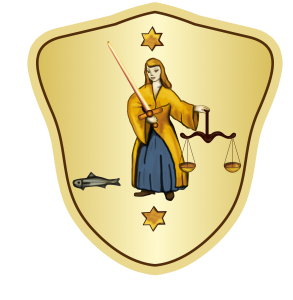(Updated July 19, 2025)
The connection of the Seulings in Alten-Buseck with some other American families of that name as yet is not fully clear. Over time we learned to distinguish two German Seuling “tribes”: a protestant one in and around Alten-Buseck in the former state of Hessen and a catholic one in and around Zettmansdorf in Bavaria. Disappointing from a genealogical point of view, and definitely highly confusing, it became obvious that the two are not related.
In this section of the “family” book as well as in the following section 10e we therefore broadened our definition of the word family. In a sense we have adopted the Bavarian Seulings. We also adopted all other American Seuling tribes that as yet we could not connect to their German roots. A warning applies: the family history of the Bavarian Seuling tribe is like an Emmenthaler cheese: a lot of holes but some real substance. We welcome any corrections and additions; we expect there will be many of both. Still what follows is a best guess.
10d.1 The American branch started by Nicholas Seuling (1875-1932)
Nicholas Fredrick Seuling was born in 1875 in the small Bavarian village Zettmansdorf.[1] The names of his parents currently are not known; his father was born on May 30, 1836 and died in 1908. Nicholas left for America at a time when many of his countrymen did the same as Bismarck set out to unify Germany and the neighboring principalities. Over a long period of time we added information, sketchy and often a bit uncertain. Anna Maria, an older sister of Nicholas’s, born on November 19, 1869, did not leave Germany. Her son, John Pflaum, later came to Ridgewood, Queens, New York. Lorenz Seuling, Nicholas’s cousin, known as Larry, was born May 11, 1883, and came to New York. His parents stayed in Germany. He died on May 19, 1909 in New York. Grete Woefel was Nicholas’s sister; she lived in Ridgewood, New York. A brother, Kaspar Seuling, lived in Eltmann (Unterfranken), Bayern before emigrating to the U.S.A.

Roots of the American Seuling branch, started by Nicholas Seuling (1875-1932).
Anna Maria Seuling (1869-1936) and the Pflaum spin-off
Anna Maria, born on November 19, 1869 and hence the oldest in the Zettmansdorf heritage as yet, did not leave Germany. Her son, John Pflaum, later came to Ridgewood, Queens, New York, possibly joining his mother’s siblings who moved there before. We have not been able to trace his American whereabouts.
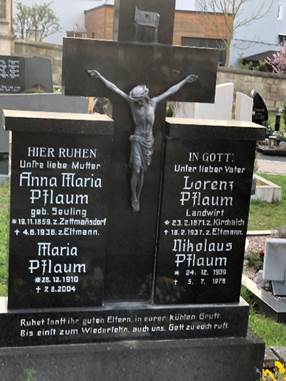
The gravestone of Anna Maria Seuling and part of her family in Zettmansdorf.

Offspring of Anna Maria Seuling (1969-1936).
Lorenz Seuling (1883-1909)
The lore on this Seuling branch is marred by one of the most poignant family tales that is recounted in the New York Times of May 20, 1909. We don’t know the background of this tragedy and are not 100 percent certain of the family ties: is Lorenz indeed a cousin of Nicholas, Anna Maria, Grethe and Kaspar and who were their parents? He probably is one and the same as the Lorenz Seuling, age 16, from Zettmansdorf who had arrived at Ellis Island in 1899 with the Southwark. From the newspaper clipping we do know Lorenz lived at 801 First Avenue and an internet search yielded the surprising insight that this is the exact address of the current UN Headquarters.
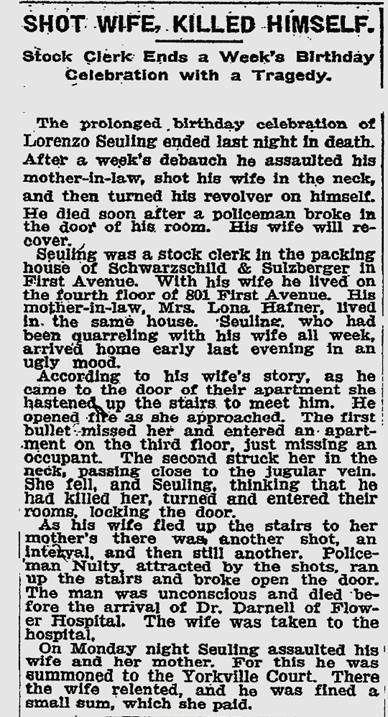
Sad story in the New York Times of May 20, 1909.
Around 1900 the physical environment in this part of Manhattan was quite different. The area was characterized by an enormous stench caused by the combination of slaughterhouses and total lack of hygiene and safety. Originally, the abattoirs were scattered all over Manhattan, but in 1898 they were officially limited to two zones. The first lay around the foot of West 14th St. (still known as the Meatpacking District today). The second zone, called the Abattoir Center, was a 17-acre tract from 43rd to 49th Streets, between First Avenue and the East River, i.e. the exact zone where Lorenz lived and also worked as a stock clerk for one of the major players, the Schwarzschild & Sulzberger Company.

Postcard view of Abattoir Center, looking north up First Avenue. No. 45 at far left.

1910 map of Manhattan with 797 First Avenue (horizontal arrow) and 349 E. 48th Street (vertical). To the left: Hudson River; in middle top: Central Park; some blocks left of the Abattoir Center: Central Station; across First Avenue: the slaughterhouses; to the right: Queens.

The Abattoir Center (encircled) on a 1926 bird’s eye map of Manhattan.
[1] Basic information on the American branch of Nicholas Seuling was kindly provided by Barbara Seuling in New York.
Nicholas Frederick Seuling (1895-1929)and his descendants
Nicholas Frederick (Nicolaus) from Zettmansdorf arrived in 1899 at Ellis Island aboard the Westernland. He initially lived at 797 1st Avenue, almost next door to Lorenz. When in America, he married Barbara Sebald – it was an arranged marriage. They later lived a couple of blocks further uptown at 349 E. 48th Street, where two children were born: Nicholas Kaspar, on November 5, 1904, and John Steven, on March 12, 1908. Nicholas worked for Swift’s meat packing plant on the East River.
When author Upton Sinclair released his novel “The jungle” in 1906, readers were horrified by its descriptions of unsafe and unsanitary conditions in meatpacking plants. Public outcry convinced Congress to pass the federal Meat Inspection Act, which required inspection of meat processing plants by the Department of Agriculture, and the Pure Food and Drug Act of 1906, which created what would become known as the Food and Drug Administration, or FDA. Indeed the images of dead animals but especially workers wielding enormous axes in close company to others don’t hold great promise.


Workers in meat packing houses; circa 1906.
In a sense Nicholas may have been one of the first beneficiaries of the new legislation when he was injured in an accident. He received a settlement for the injury and with that money, Nicholas, Barbara and the two boys moved to Ridgewood, located in the borough of Queens, bordering Brooklyn, approximately 20 miles northwest of Midtown Manhattan. The neighborhood provided a home-away-from-home to its many German immigrants. They bought a house at 385 Onderdonk Avenue, and on the ground floor opened a tobacco & candy store. It was a huge change from the Abattoir Center!

Ridgewood overview with Onderdonk Avenue diagonally from top left to bottom right.
In this new environment another child was born in November 1909, who died a month later. On October 28, 1910, a daughter, Teresa, was born. A year later, on August 11, 1911, there was an accident and Teresa died. Nicholas Frederick (Fred) was the last child born to the couple, in their attempt to have another daughter. He was born in Queens, on June 3, 1912.
As yet we have no further information about father Nicholas except the newspaper announcement of his decease in 1929; he then lived at 408 Onderdonk Avenue. When mother Barbara died in 1936, the newspaper clipping says she lived at 195 Onderdonk Avenue. According to another of the mysteries within this Seuling branch, after she had returned to Bayern, Germany where she died on February 1, 1936. The newspaper texts leave little doubt of their German roots, however: the service for both Nicholas and Barbara were held in the St. Aloysius R.C. Church.


Newspaper announcements of the deaths of Nicholas and Barbara.
- Some 30 years later their namesake Karl (Charles) Seuling from the Alten-Buseck tribe (see further on) lived at 679 Onderdonk, just past the intersection with Gates Ave in the far right bottom corner.
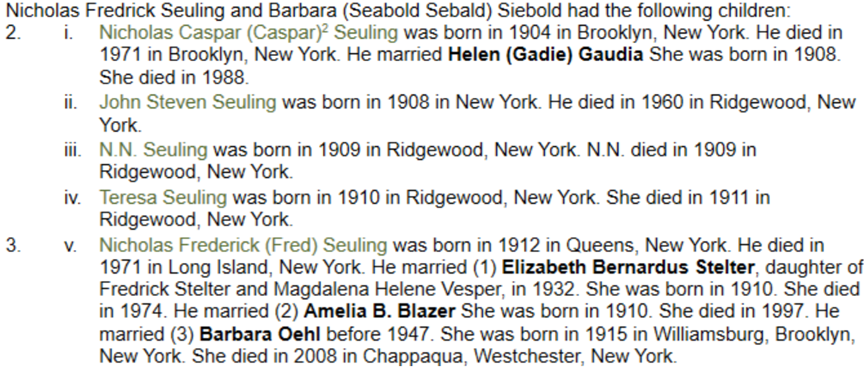
Offspring of Nicholas Fredrick Seuling (1875-1929).
Of their five children, three can be traced within the New York area: Nicolas Caspar (Caspar), John Steven and Nicolas Frederick (Fred).
Caspar Seuling (1904-1971)
Nicholas Caspar married Helen Veronica Gaudio (also: Gadie) and lived in 95 Bay 29th Street in Brooklyn. Caspar was a Post Office mail carrier. The couple had three children: Philip Nicholas (Phil; born January 20, 1934 in Brooklyn, NY); Barbara Maryann (born July 22, 1937 in Brooklyn, NY); and Dennis Kaye (born November 7, 1946 in Brooklyn, NY). Nicholas Kaspar died in 1971 in Brooklyn, NY.
Descendants of Caspar Seuling (1904-1971).
Phil Seuling (1934-1984)
Phil was born in the Bensonhurst neighborhood of Brooklyn, NY, where he spent his entire life. He graduated in January 1951from Lafayette High School, fourteen blocks from home. He enlisted in the Army on January 18, 1954 and was discharged on January 17, 1956, apparently serving at Fort Dix in New Jersey. Phil continued his education at City College of New York and graduated with a Bachelor of Arts degree. At City College, Phil had met Carole Petersen whom he married in 1958.
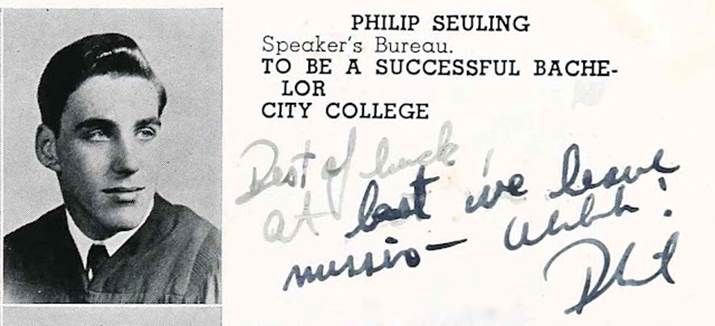
Paying the bills.

Long Island Star-Journal, June 19, 1958.
In 1958, he and a friend began buying and selling back-issue comic books. To his surprise, the value of classic comics grew by leaps and bounds. He recalled that he estimated the worth of Big Little Books at five dollars at most, but realized he was wrong when an old lady called up to say she was offered ten dollars each. Thus, unexpectedly, Phil made a fortune buying comics for next to nothing and selling them for a mint. In 1967, when he was an English teacher at his alma mater, Lafayette High School, he organized the first major comic book convention. Called the Comic Art Convention, there were tables and tables full of golden age and silver age comics, big little books, newspaper strips, pin-ups, movie posters and original artwork. People came to sell their comics collection, “trying to raise money for dental bills not covered by insurance”, as one of the early participants remembered. “I was stationed in the huckster room with a few boxes of fairly ordinary comics on the table in front of me and a box of the truly valuable ‘stock’ by my feet. This included the very first comic with a Spiderman story, Amazing Fantasy # 15, which is worth over a thousand dollars today.” Phil’s conventions, throughout the 1970s held in New York City every July 4 weekend, became a virtual brand name; he is mentioned in almost all historical reviews of American comic book art as well as in a publication Fifty Who Made DC Great (DC Comics, New York; 1985).

Phil Seuling
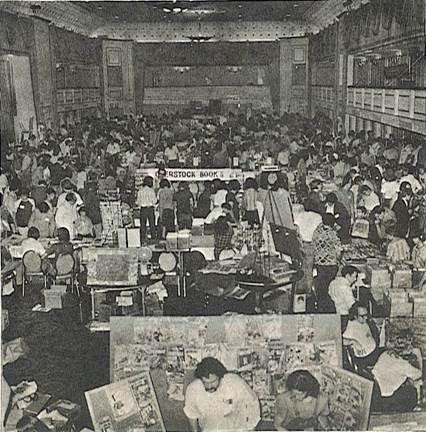
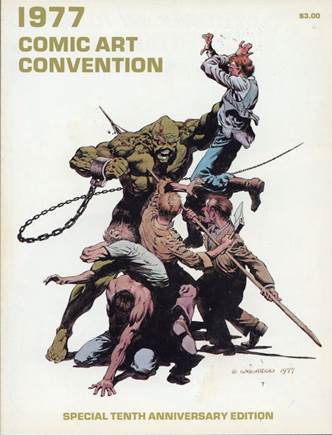
Phil Seuling’s Comic Art Convention of the early 1970s in New York.
When he passed away in August 1984, the headline in the Comics Journal read “Phil Seuling, father of the direct-sales market, dies at age of 50”.
The formal tributes said it all: “Phil Seuling was a comic book retailer, fan convention organizer, and comics distributor primarily active in the 1970s. He was the organizer of the annual New York Comic Art Convention, originally held in New York City every July 4 weekend beginning in 1968. Later, with his Sea Gate Distributors company, he developed the concept of the direct market distribution system for getting comics directly into comic book specialty shops, bypassing the then-established newspaper/magazine distributor method, where no choices of title, quantity, or delivery directions were permitted.” He was laid to rest with his Captain Marvel costume.
Phil’s spouse Carole Petersen was an accomplished cartoon artist in her own right, who co-created the well-known Shanna the She-Devil character in 1972. They grew apart as Phil became more interested in hippie culture, separating in 1971 and eventually getting a divorce but remaining close. Phil entered a romantic relationship with Jonni Levas, a former student who was instrumental in running Sea Gate.
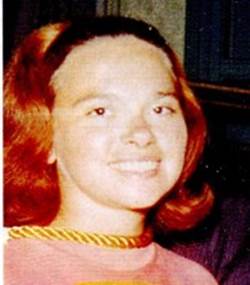
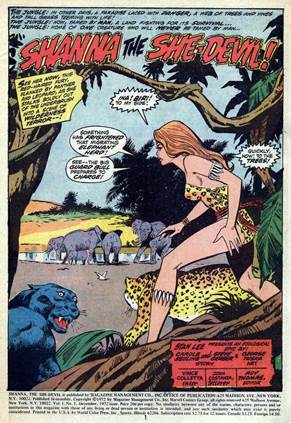
Carole E. Petersen. .. …and her creation, Shanna, the She-Devil.

Shanna-the-she-devil
The couple had two daughters, Gwenn (born October 25, 1960) and Heather (born November 9, 1962).
Many years later, Gwenn was a second generation comic book fan and member of a self-publishing group. ”When I was 10, I started drawing index-card comic books for my younger sister – she had to pay me 10 cents,” she recalled. ”What else? I always wanted to make money.” The girls, and their mother, also actively participated in the events that their father organized such as the 1968 International Convention on Comic Art held at the New York Statler-Hilton. The contestants for the costume contest included “the Phantom Detective, Blue Beetle, two Spectres, Green Hornet, Merlin the Magician, Iron Man, Barbarella, Captain Marvel Jr., Queen Hippolyta (Carol Seuling), Wonder Girl and Wonder Tot (the Seuling girls).”
In a remarkable coincidence long-time comic book collector Warren Reece – at the time seventeen years old – recalls the life-changing event that took place the next day. His father brought some newspaper articles about the convention home; one had a photo with convention chairman Phil Seuling’s little daughters, Gwen and Heather. “On Sunday, July 7th, my father’s birthday, he and I got onto the train to Manhattan, to attend the last day of the convention. On the way into the Statler Hilton Hotel, I bought a Marvel Boy #1 for four dollars, and, up on the eighteenth floor of the hotel, I really got to work, going from table to table, asking the dealers whether they had Marvel Mystery Comics #1 or Captain America #1.” Apparently, one of the traders was touched by his awe, because “the batch was priced at $152.00, but he let me have it for $125.00, which constituted my life savings. I was never happier to go broke!”
He was hit by the windmill – never the same again. “I called Phil Seuling, and he had a beautiful Marvel Comics #1 for sale at the price of $250.00. I think I worked for my dad in order to earn a little extra. After some rocky negotiations, my dad and I went up to the Seulings’, whose apartment overlooked the famous Cyclone roller coaster in Coney Island. … Upstairs, we were greeted by Phil. … Phil took my dad and me into a little back room, where he kept lots of Golden Age mags, and two framed pieces of original art.” He pulled Marvel Comics #1 from a box on a top shelf. With trembling hands, I counted the pages, glimpsing wonders as I went through the mag.”
“I paid every penny I had in the world to Phil, along with a large loan from my father which I repaid over several months, and, bidding goodbye to Phil, Carole, and little Gwen and Heather, who were two of the most precious little girls I’ve ever known, my dad and I drove back to Sheepshead Bay.” He was “broke, in debt, and stunned. It was the best purchase I ever made, with the possible exception of my original, illustrated ‘King Kong’ script, years later.”
Little Gwenn grew up and in 1999 received her Masters Art in education printmaking at Florida Atlantic University. She went on to become art instructor within the school district of Palm Beach County. She also teaches online art courses and is outreach educator for the Boca Raton Museum of Art in Florida, creating lessons, content, and organizing materials to teach children about the artworks. It is a long time dream that came true: “I have been working since I was thirteen-years-old and sold my handmade concert t-shirts outside Madison Square Garden. I have always made art, and started teaching almost by accident only to find that I loved it. Combining the two is a dream. It could only be better if I had animals in there somehow…”
She also is the illustrator of books such as It Is Illegal to Quack Like a Duck & Other Little Known Laws (1988), written – it is no surprise – by Barbara Seuling. Her aunt loves her work: “Gwenn is an exceptional artist and teacher who woks briilianly with students and is instrumental in guiding their art education and their individual strenghts and talents.”
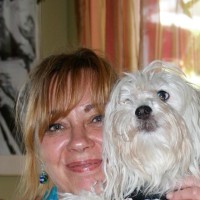
Gwenn Seuling
“Gwen and Heather Seuling grew to be beautiful young women, and married”, Warren Reece remembered. Gwen married a French producer, Jean Philippe Ghielmetti. In 1985 Heather followed, marrying John Antonelli.
Barbara Seuling (1937-2016)
“I have traveled to many places and seen wondrous things — the ruins of Pompeii, the Parthenon in Athens, Hamlet’s castle in Denmark, the Tower of London, a cloud forest in Costa Rica…but I always write about what I know best. I always come back to life as I knew it in Brooklyn, as a child.” This is how Barbara told about herself: where she gets many of the ideas for her books and what she has accomplished as yet.
Seuling was born July 22, 1937. “I was born in Brooklyn, New York, which seemed like the most exciting place in the world. In the summertime, the whole family would go up on the roof of our building to see the fireworks on Coney Island. It was a short walk to Gravesend Bay, where we saw great freighters coming in and out of New York harbor . There were new movies every Saturday at one of the neighborhood movie theaters, a library a few blocks away, and always armies of kids to play with, so I can’t say I thought much about writing. I did draw, though, from the time I could hold a pencil.”
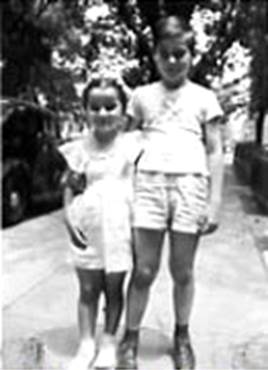
Barb Seuling, age 4, with brother Phil.
Her mother instilled in her a love of reading and books – and the habit of spending Saturdays in the local public library. Summers were often spent at family members’ beach bungalows or in the country where she was able to roam and learn about nature with her cousins and older brother. Her younger brother Dennis was born when she was nine, and she has noted that it was reading to him that cemented her love for children’s books. Thus it is no surprise that she credits her Brooklyn years for much of her inspiration. “When, one day, the writing bug bit, all those great times back in Brooklyn came back to me in floods of stories and pictures. My freaky fact books were a direct offshoot of my early fascination with Ripley’s Believe-It-Or-Not series in the Sunday funnies. The Teeny Tiny Woman is a kind of tribute to my love for folk and fairy tales, which consumed me until I was eleven or twelve. The Triplets sprang from the irritating way adults compared me to my older brother.
Barbara was a good student before and after a rough and awkward patch during junior high. When she was a young teenager in the early 1950s, Seuling said a film about singer and actress Jane Froman, With a Song in My Heart, changed her life. She became fascinated with the story of Froman’s recovery from terrible injuries suffered in a plane crash during a 1943 USO tour. Barbara joined the Jane Froman Fan Club, the Fromanettes, a group of like-minded girls she met when she tracked down Froman’s Manhattan address. Though it was Froman’s voice as well as her beauty and grace on stage that first captured the girls’ admiration, ultimately the star’s indomitable spirit and courage captured their hearts and inspired lifelong devotion.
The young girls went from attending Froman’s weekly live television shows and rehearsals to spending long afternoons on the star’s front stoop on East 93rd Street in New York City. Over the years, the girls realized the pain Froman suffered through dozens of surgeries to repair her battered body and how she had continued to perform to pay off hundreds of thousands of dollars in medical bills. The Fromanettes also were among the few people who knew Froman stuttered when she wasn’t singing. The condition was so extreme, Froman declined talking on the phone. Still, she made time for her young fans, often inviting them into her home and hosting parties for them.
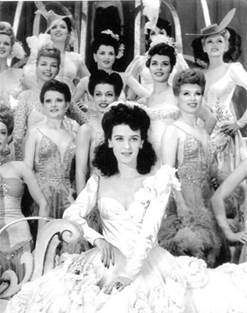
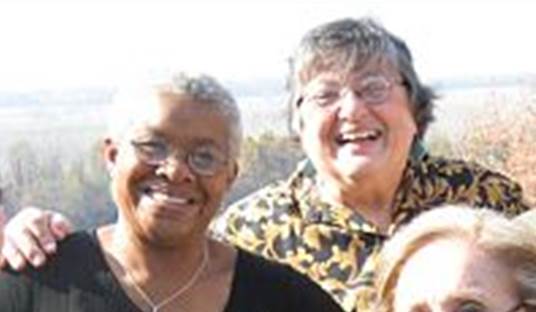
Left: Jane Froman; right: Winnette Glasgow and Barbara Seuling at the Fromanette reunion; 2007.
They confided in Froman, and she in turn listened to their hopes and dreams. For the girls, the fan club sparked lifelong friendships and inspired careers many of the women credit to Froman’s encouragement. Barbara and Jane Froman eventually met and became close friends, and another member of the Fan Club, Winnette Glasgow, became her best friend, and later, her wife. It was through her work on a newsletter for the Fan Club that Seuling first dipped her toe more seriously into writing, drawing, and editing. As Barbara told it, Jane was the reason she began writing. Winnette was the editor and Barbara was the assistant editor, writer, and illustrator of the club journal, where she contributed a series called “Lil’ Janey”.
Some 55 years later, in 2007, “The Fromanettes” reunited from across the country to pay tribute to Froman. At that time Barbara Seuling, who first met Froman on her front stoop, completed a book. “Say It with Music: The Life and Legacy of Jane Froman”. “She showed so much interest in us and cared so much about what we were doing,” Seuling said. “As teenagers, she was like a big sister to us. She just listened to us; she didn’t judge or scold.” When she was older, Barbara asked Froman why she put up with a bunch of teenage girls interrupting her weekends and following her around. “She looked right at me and said, ‘Because I love you,’ ” Seuling recalled.
Upon graduating from high school, Seuling studied at Hunter College in Manhattan while working a full-time day job at an insurance company. At age 19 she found a job at Columbia University, where one of her benefits was free college credits. But the grueling pace of working full-time and going to night school got to be too much and Seuling ended her studies after several years. Seuling’s first official step into publishing was when she landed a job as a secretary to two editors at Dell Publishing, where a fledgling children’s books department was just being established under the leadership of Lee Hoffman. Hoffman took Seuling under her wing, and when the children’s department expanded, offered her an assistant job. Hoffman left Dell and she was succeeded by George Nicholson, to whom Seuling became an assistant. She learned about all the various publishing departments as Nicholson grew the division and established the Yearling line of paperback reprints and Delacorte Press, among other things. Nicholson gave Seuling her first true illustration job as well, when he assigned her the artwork for a middle-grade novel. On her own, she had also begun writing the Freaky Facts nonfiction series published by Xerox Educational Publications.
When Nicholson later moved to Viking, he published Seuling’s first picture book there, The Teeny Tiny Woman: An Old-English Ghost Story (1976). She wrote and illustrated several more picture books, and also illustrated picture-book texts for other authors. In addition, she continued with the Freaky Facts books and other nonfiction, as well as puzzle books. She left Dell in the early 1970s and worked for two years at Lippincott before deciding to become a freelance writer and illustrator.
Her body of work continued to grow. Over a long period of time she published a great many books with some of the wildest and funniest titles on record: Bugs That Go Blam & Other Creepy Crawler Trivia, Elephants Can’t Jump and Other Freaky Facts About Animals, You Can’t Sneeze With Your Eyes Open and Other Freaky Facts About the Human Body, The Last Cow on the White House Lawn and Other Little-Known Facts About the Presidency, The Last Legal Spitball and Other Little-Known Facts About Sports, The Loudest Screen Kiss and Other Little-Known Facts About the Movies, You Can’t Show Kids in Underwear and Other Little-Known Facts About Television, You Can’t Eat Peanuts in Church and Other Little-Known Laws, Who’s the Boss Here?: A Book About Parental Authority, and the Teeny Tiny Woman: An Old English Ghost Tale.
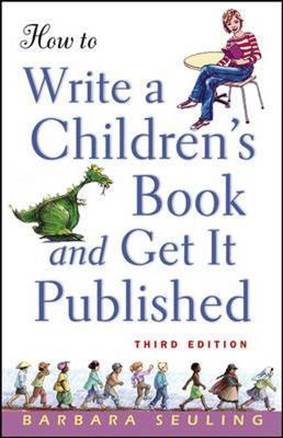
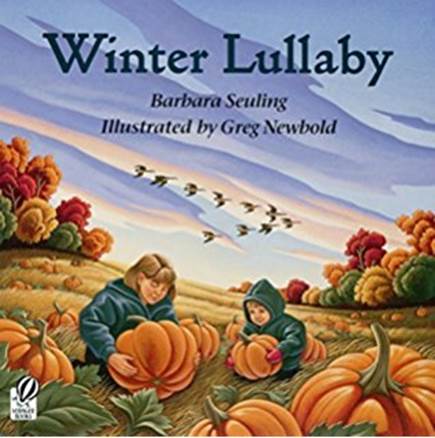
Covers of books by Barbara Seuling.
Outside of her own children’s book projects, Seuling used her extensive publishing experience to lead small private writing workshops. Her adult nonfiction title How to Write a Children’s Book and Get It Published, first released in 1984, was considered a key read for aspiring authors and is currently in its third edition. She taught a class in writing for children at the Graduate School at Bank Street and offered workshops and lectures in Manhattan and summer writing workshops in Vermont. With fellow author and editor Fran Manushkin, she took part in an education project in early 2002, sponsored by the George Soros Foundation that involved teaching the craft of picture book writing to a group of students (who were selected in an application process) from 28 countries in what was formerly the Soviet Union. The project was rewarding in many ways, especially because Seuling has said, “Of all I have written, the work I love best is in picture books. Picture books offer the greatest challenges and bring the most satisfaction.”
Thus Seuling’s work lives on through a great many writers. Highly regarded author Nancy Garden fondly remembered: “My first children’s book, Aloysius P. Bookworm, was a collaboration with my best friend, Barbara Seuling. … Barbara did the pictures, I did the text, and between the two of us, we probably made just about every mistake a budding author and a budding illustrator can make! Luckily, we never had Aloysius published – I’m not sure we ever even tried—but we had a great time creating it, and we learned a lot from our mistakes.” Children’s author Marvin Terban, who co-founded a renowned writers group with Seuling, recalled: “She was a major influence in the children’s publishing world, especially through her classic book How to Write a Children’s Book and Get It Published.”
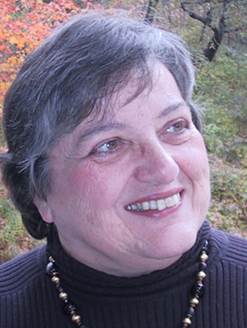
Barbara Seuling.
When Barbara Seuling died September 12, 2016 in Lebanon, N.H. of complications from cancer, she was the best known of the worldwide Seuling tribes.
Dennis Seuling (born 1946)
Barbara’s younger brother Dennis Kaye wen to Lafayette High School in Brooklyn and subsequently studied Speech/Theatre at Brooklyn College, receiving a Master of Arts in 1968. He married Susan R. Schwartz in 1971 in Brooklyn and had two daughters, Elizabeth (born in 1975) and Pamela (born in 1978).
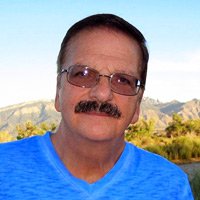
Dennis Seuling.
From 1975 until 2002 Dennis worked as a high school teacher and college advisor at the John F. Kennedy High School in th Bronx. Film was his lifelong love, however, since he cringed when a harpoon came hurtling toward him in the 3D Creature from the Black Lagoon. He taught for many years in New York City public high schools, where he introduced courses on Film History, Film Making, and Horror/Fantasy Film. He supervised the production of student-made films, several of which won scholarships for intensive summer media study for his student filmmakers.
He also became the film and home video reviewer for the New Jersey newspaper The Villadom Times for over 25 years. He has reviewed films for the New York City Board of Education, written study guides for 20th Century-Fox releases, and contributed entertainment-related articles to various publications. Before joining the staff of The Digital Bits, Dennis covered new Blu-ray and DVD releases for the online website Next Projection.
His daughter Elizabeth is born in 1975. She lives in Maywood, New Jersey.
Pamela Anne (1978) married Armand Bertolt Sebastian Turk in 2008 in Sea Bright Borough, New Jersey.
John Steven (1908-1960)
Returning to the offspring of Nicholas Fredrick Seuling (1875-1929), Caspar’s younger brother John Steven never married. He died in June 1960 in Ridgewood, New York.
Fred Seuling (1912-1971)
Third son Nicholas Frederick (Fred) married three times. Although we need confirmation, he apparently married a first time in 1932 with Elizabeth Bernard Stelter (1910-1974); nothing further is known. The second wedding was with Amelia Blazer (1910-1997). The couple had daughter Marilyn Ruth (1933) and must have divorced. During World War II Fred was SK/2C in the US Navy. Before 1947 Fred married again with Barbara Oehl. Barbara worked in an electronics manufacturing plant and was a labor union organizer. Together they had daughter Barbara Ann in 1947, whereas Barbara also served as a loving stepmom; her sister Gloria remembered how much Marilyn as a young girl loved to read poetry with her.

Offspring of Fred Seuling (1912-1971).
Marilyn Ruth married Richard Norris in 1952 and stood beside him during his extensive military career in the Navy. She followed him around the world after the Civil Service called him back to government work. She had earned her Bachelor’s Degree and her Master’s Degree in Vocational Education from The University of Southern Mississippi in Hattiesburg. Her employment history is as long and as varied as her life was, but she was happiest while working as an Education and Curriculum Specialist, most recently at the Memorial Hospital at Gulfport in the Education and Research Department.

Marilyn Seuling (1933-2004).
Marilyn and Richard had eight children: Richard Frederick (1953), Robert Francis Stephen (1954), William James (1955), Lawrence Andrew (1958), Barbara Bernadette (1960), John Tracy (1962), Maureen Bridget (1968) and Laurel Anne (1970). When she died in 2004 she had twenty-five grandchildren; and nine great-grandchildren. Her obituary recounted warm memories to cherish. Friends playing cards with her and the kids. Marilyn in the kitchen fixing someone something to eat. Memories of her telling stories. How she always had a present underneath her tree at Christmas time for any guest that may come that way. How she always would ask for people to come over at Thanksgiving to share the holidays with her and her family. How she always took in strays because, as she said, a stray needs love as much or more than the average person.
Barbara was a candidate for a Master of Laws degree at the New York University School of Law, when she married Michael Burr Gerrard in 1976. In an extensive 2020 publication[1] the bridegroom recalls how, after obtaining his degree at Columbia Law School, “he briefly worked as a paralegal at a Wall Street law firm, where he met a wonderful young woman, Barbara Seuling, who also worked there as a paralegal while she put herself through law school.” They started dating (and married in 1976).
It was the era when most of the major U.S. environmental laws were being passed, and it looked to him that the most effective environmental work was being done by the lawyers. So after becoming an environmental lawyer at NYU Law School he joined a small environmental boutique Berle, Butzel & Kass and subsequently the New York office of major law firm Arnold & Porter. Around 1990 climate change reached the environmental agenda, culminating in the United Nations Framework Convention on Climate Change in 1992, and the Kyoto Protocol, which was designed to implement it, in 1997. Working on a book Global Climate Change and U.S. Law, he became “extremely concerned”.
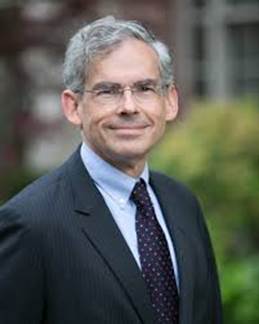
Michael Gerrard.
When in 2008 the dean of Columbia Law School asked him to join the faculty to teach environmental law, he resigned his partnership in Arnold & Porter – “happy to give up my thirty-year habit of filling out a time sheet every day” – and became a full-time professor. It was a time of rapid ups-and-downs, the UN climate conference in Copenhagen in December 2009 being a case example of the latter. Donald Trump, who in 2009 as a private citizen (together with Donald Jr., Eric, and Ivanka) had signed a full-page ad in The New York Times calling for international climate action, began tweeting in 2012 that climate change was “a Chinese hoax.” The tremendous optimism of 2009 had soured, but the scientific case for urgent action was becoming even more compelling. To undermine this sense of urgency, opponents of climate action began attacking climate scientists.
In 2010 the Republic of the Marshall Islands asked him for help. Their island nation, half-way between Hawaii and Australia, would in time be under water. That raised several novel legal questions: Is a country that is under water still a state? Does it still have a seat on the United Nations? What will be the legal status of its displaced people? Is there any recourse against those who did this? Michael once again became deeeply involved. He learned of the direct impact of climate change and the lasting damage due to nuclear testing: remember Bikini? His conclusion: “The United States has shafted the Marshall Islands in three ways: we dropped sixty-seven nuclear weapons on them; we established a tribunal to judge their claims, but then never paid them; and now they are drowning from sea level rise that is caused in part by the United States. More than any other country, the Marshall Islands are the victims of the two greatest threats facing humanity: nuclear weapons and climate change.”
The last two decades climate change litigation is burgeoning around the world. Because governments and legislatures everywhere have failed to take adequate action, activists are looking to the courts. His Columbia research center attempts to track all climate lawsuits in the world. “By our latest count, there are more than 1,452 such cases in thirty-seven countries. The United States is by far the leader, with 1,134 cases; Australia is a distant second with ninety-five.” However, only one such lawsuit has succeeded: Urgenda Foundation v. Kingdom of the Netherlands. In December 2019, the Dutch Supreme Court upheld rulings of the lower courts that the European Convention on Human Rights obligates the Dutch government to reduce the country’s greenhouse gas emissions emissions even further than its pledge under the Paris Climate Agreement. This litigation has inspired similar lawsuits in several other countries; so far none have succeeded, but a few are still pending.
Barbara and Michael Gerrard had two sons, David and William, that in turn produced offspring. They are a source for inspiration to keep on fighting the Good Fight, Michael concludes. “This all became much more personal for me in April 2018 when Barbara and I were blessed by the arrival of our first grandchild. Our second came in August 2020. Today, nothing motivates me to fight climate change more than holding our Amelia and her little cousin Neri, who should still be around in 2100, and thinking about what kind of world they will live in. I don’t know if my professional work will actually help give them and their generation a better world, but it is profoundly satisfying to know that I’m trying my best.”
Kaspar Seuling (born 1880)
It is a major jump back to the -as yet – nameless Seuling who was the father of Anna Maria (married with John Pflaum), Nicholas Frederick (extensively discussed in the preceding text), Grethe (married with an unknown Mr Woefel) and Kaspar (married with Barbara Reitz). We know little about Kaspar, luckily more about his two kids.

Offspring of Kaspar Seuling (born 1880).
[1] Michael B. Gerrard, An Environmental Lawyer’s Fraught Quest for Legal Tools to Hold Back the Seas, 149(4) DAEDALUS 79 (2020)
Margaret Seuling married Adam Dannhardt (1899 Brooklyn -1966 Nassau, New York) on 25 August 1929 in Queens. Living in Queens, they were the parents of daughter Mildred.. In 1920, his occupation is listed as machinist. He died in October 1966, in Nassau, New York.

Descendants of Margaretha (Greta) Seuling.
Mildred was born in Glendale in Queens and married Edward Breitenbach, who grew up across the street from her. She was the mother of two sons, Thomas and Joseph, both of whom married and had two kids. After moving upstate with her family, she was editor for the Mill Hill Missionary Magazine for many years. She was an interior designer and manager for her husband’s architectural practice, specializing in hospitals and nursing homes. She co-founded Albany County Right to Life, the Catholic League for Religious and Civil Rights and the St. Joseph Marian Center for which she edited their newsletter.

Mildred Breitenbach.
Kaspar’s son Henrymarried Hella Horn. Despite serious efforts we know little about them. They has at least five children, who all married. Only the oldest two have “surfaced”.

Offspring of Henry Seuling (1911-1973)
Rita G. Seuling (abt 1937 Lynnbrook, Long Island – 2012 Albany; at the time lived in Duanesburg) was a graduate of Schoharie Central High School. She was employed for 15 years as a secretary for the Golub Corporation in Rotterdam, New York, retiring in 1999. Rita was a member of the Schoharie Valley Hay Shakers Square Dance Club and Akin’s Angels Ride for Strides. She was also a 4-H leader for many years. Rita loved her gardening, her cats and feeding the birds.
Rita married Dominick A. DeCocco on May 25, 1957. The bridegroom enlisted in the US Army in 1954 and served during the Korean War in Germany as part of the infantry assigned as an assistant gunner. Upon his honorable discharge, he returned to his native town of Princetown and began a long working career first with Bellevue Dairy and then for GLF (later Agway) in Altamont, driving bulk feed to area farmers until his retirement. Always keeping busy, Dominic later found work operating fork lift at the Golub Corp. in Rotterdam along with operating his own beef farm as the 2nd generation, which will live on through his sons and grandsons. Dominick was a proud member of the NRA and enjoyed hunting, square dancing, collecting antique tractors and running the DeCocco farm. Hek passed away at his home on Duanesburg Road in Princetown, NY in the same room he was born in. His sister in law Jean fondly remembered how she first went camping with Rita and Dominick “and a black bear woke us up.”
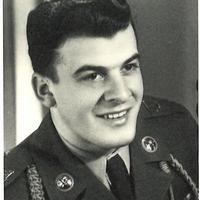
Dominick A. DeCocco
Rita and Dominick had three children, Steven, Ronald and Beverly.

Offspring of Rita Seuling.
Beverly was born in Niskayuna in 1963. She served as the Director of Financial Services for the Golub Corp. of Schenectady, a position she rose to from starting as a clerk at age 16, she worked for 34 years, right up to the last couple of weeks. A former 4-H member, Bev loved caring for and riding horses all her life, especially Tucson and Hank and her deceased favorite Dawny. She also enjoyed flower and vegetable gardening and following her sons Motocross races. Akin’s Angels was established early in Bev’s battle with breast cancer as a fundraiser and way to raise awareness. The couple had sons Raymond Gordon and Justin.

Beverly DeCocco.
Lorenz “Larry” Henry Seuling (1938 Lynwood – 2021 Russellville, Arkansas) was a United States Army Veteran and worked at the Walter Reed National Military Medical Center repairing hospital equipment. He graduated from Hudson Valley Technical College and moved around quite a lot, residing in eleven different cities: Dallas, Genoa City, Milwaukee and Kenosha, all three in Wisconsin. Settling in Mountain Home, Arkansas, Larry was the Exalted Ruler at the Elks Lodge in Mountain Home.
His sister Jean fondly remembered her big (and only) brother. “He pulled many pranks when he grew up. There was the time he asked me to hold these two pipes and then he turned on a transformer. I stood there shaking for a few seconds crying. Another time he tried to open a bullet or shotgun shell in Dad’s workshop. It either exploded or he tried to light the gunpowder. In any event he was hit with shrapnel. Those were the times.”
Larry and his spouse Patricia Kreigbaum had two kids.

Offspring of Larry Seuling
Their daughter Lisa sadly died, just 21 years old, in an automobile accident in Mukwonago, Wisconsin, where she had graduated at Mukwonago Senior High School. She was employed as a secretary at Ryder Truck Rental in Waukesha, and was a model for Cinderella Fashions.

Lisa Seuling
Her brother Lorenz S. Seuling profiled himself as “a small business owner as well as an adrenaline junkië. Sportbikes and stuntin!!” The internet bears out the message. Not all observers appear equally charmed by his exploits. In May 2018 the Baxter County Sherriff issues a warrant for “failure to appear-misd”. In 2003/5 his Kenosha county colleague had gone slightly further when he was booked for “P & P violations” and “WAW/WRIT of body attachme”. However, a couple of manuals, however, are indicative of the way he is turning his roadmanship into a business opportunity: if you want to give your vehicle a shot of adrenaline, Larry is your man with his Kingpin Lithium outfit.

Lorenz S. Seuling


Critical observers.


Manual written by Lorenz Seuling.
Henry Seuling and Hella Horn had three more daughters: Jean, Doris and Irene. Of the latter two, we know they were married but that’s it.
10d.2 William Seuling (ca. 1850) and his tentative NY branch
This section started with a footnote that stuck around in earlier manuscripts of the Seuling family book. Some thirty years ago, our American cousin Margaret McKenna informed us that her father-in-law Charles Henry Seuling (1904-1959) had “a distant cousin Henry J. Seuling who lived in Ridge, N.Y. and who in turn had a son Henry J. Jr. of Hicksville and Greenville, N.Y. and a grandson Robert W. living in Port Jefferson Station, N.Y.” Our genealogical problems were enhanced due to the fact that two subbranches in the New York area refer to a William (undoubtedly Wilhelm) Seuling and Margaretha Seuling, later on clarified as Margaretha Becker, as their German root connection.
What follows is our current best guess. For the time being, we “promoted” William to pater familias of three sons: Karl (Charles), Henry Wilhelm and an as yet nameless son. The nameless son was the father of Henry J. Seuling. It could be right, it could be wrong. In the latter case we will have to change it.


The tentative descendants of Willam (Wilhelm) Seuling (born about 1850).
Karl (Charles) Seuling (1876-1940)
According to the family lore among his American descendants, Karl[1] (Charles) emigrated from Baden-Baden, Germany, at the turn of the 20th century. With one notable exception we did not find any other reference to Seulings from that major city in Würtemmberg: Conrad Seuling, age 25, from Baden arrived in 1850 aboard the Leila. We never found his traces in the U.S.A.
It did remind us though of Johann Jost (Justus) Seuling (1801-1873; see section 10b) who moved to a small property belonging to the Badenburg, close to Alten-Buseck.
Family lore tends to be a good source of information but is notably weak on places; Baden-Baden, a well-known southwestern German town, could easily be a distortion of Badenburg, a family home in the mid 1800s. For a long time we pursued the hypothesis that for the German connection we had to look to Justus and his mini-branch.
Until we read his naturalization and death certificates. Karl, who upon his arrival in 1890 never left Brooklyn, passed away in 1940. He was born on January 30, 1876 in Badenhauser, Germany and according to the death certificate his parents were William Seuling and Margaretha Seuling, both born in Germany. Important from a genealogical perspective, he was buried at the Lutheran Cemetery. The source of information on the certificate is his spouse Anna Seuling-Miller. The data thus can be assumed to be fairly reliable.
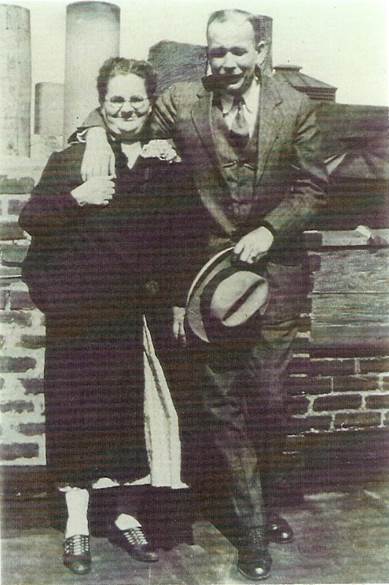
Karl (Charles) Seuling and Anna Miller.
Badenhauser as place of birth creates a problem. It is a small village with currently less than 2,000 inhabitants in the state of Lower Saxony (Niedersachsen). Is this a separate Seuling branch or a spin-off from Alten-Buseck, at a considerable distance? The burial at the Lutheran Cemetery makes it unlikely this is a branch of the Bavarian Seuling tribe.


Charles Seuling, born in 1876 in Badenhauser, Germany, becomes a U.S. citizen; November 30, 1936.
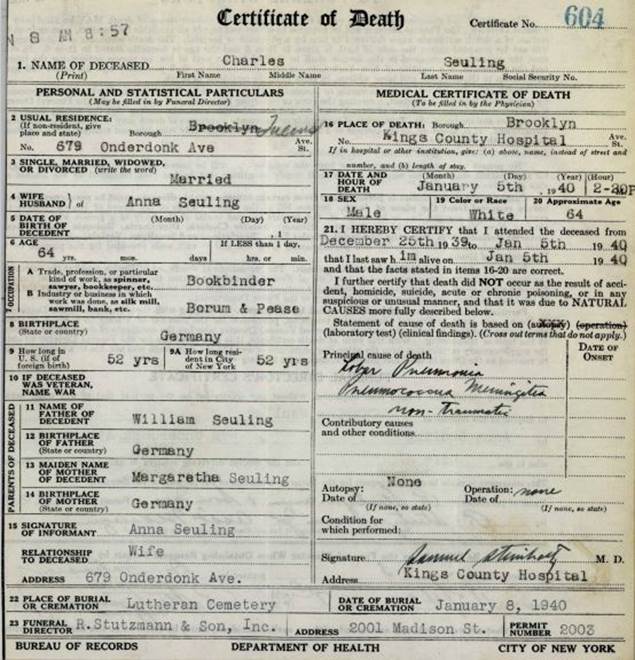
Certificate of death of Karl Friedrich Wilhelm / Charles Seuling.
Changing his name to Charles, Karl settled in Brooklyn, New York where he married Anna Miller (1876 USA – 1941 Queens), the daughter of Christ Miller and Katherine Omstead. When Charle died, Anna provided their address: 679 Onderdonk Avenue, the same street that housed a number of Bavarian Seulings before (see section 10b). Old and new images take us back to the heavily German immigrant population of the early 20th century Ridgewood neighborhood within sight of the famous New York skyline.
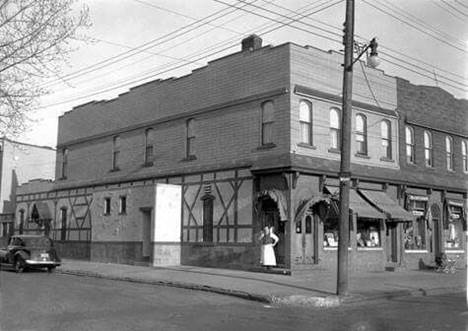
German Tavern, one block from 679 Onderdonk Ave.; 1930’s.

Onderdonk Avenue, two blocks down from number 679 at Grove Street; 1941.

679 Onderdonk Avenue (with the canopy), near the corner of Gates Ave

Graffiti on Onderdonk Avenue, with the Manhattan Skyline in the background.
The closest relatives of Karl – his son William Seuling and daughter-in-law Luise and granddaughter Margaret McKenna Seuling – provided us with some background. According to William, his father never spoke about his life in Germany. In Brooklyn he was a bookbinder at Boorum & Pease, a company that had been around for “ages” specializing in notebooks for laboratories, ledgers for accounting, receipt books, etc.
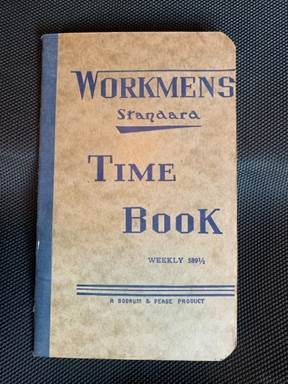

Borum & Pease time book and a 1904 advertisement.
Together Charles and Anna raised a family of five children. William remembered how his mother always called his father “Karl”, and they often spoke to each other in German. None of the children spoke the language, however, except for a few important words such as “Dummkopf” and “Hosescheisser”. With their input, the family tree of this first American Seuling came alive.
Offspring of Charles Seuling (about 1888 Germany – 1940 Brooklyn, NY).
Daughter Margaret was born in 1902 and married Edward Ulrich; according to our current information the couple had one daughter Catherine who was a dancer in the Radio City Music Hall in New York City. After her marriage she moved to California where she still lives.
Oldest son Charles, born in 1904, worked with a bank and married Elizabeth Morgan. One of their sons died in infancy.
Donald, however, was in the United States Air Force from 1951 till 1955 during the Korean War. In 1956 he married our correspondent Margaret McKenna. She raised their four sons alone after his sudden death from a heart attack at the age of 40. They all turned out to be fine young men, most of them having started a family of their own by now.

Descendants of Charles Seuling (1904-1959).
[1] The information on this first American branch was kindly provided by Karl’s youngest son William Seuling and his spouse Luise who well into their eighties lived at 120 SW 10th Court, Boynton Beach, FL 33426, and by Mrs. Margaret McKenna Seuling, 52 Brandy Lane, Lake Grove, NY 11755.
Son Stephen (1958-2021), for instance, was a long-term employee of Prudential Securities in Manhattan, where he served as a Manager of Operations. His interests included American History, Cape May, and he was an ardent Harry Potter fan. He was very patriotic and had served in the Marine Reserves. Stephen met his wife, Robbin, while working at Prudential Securities. Robbin had a difficult childhood, and it was Steve who saved her by providing her the security, protection, and the love she always needed. They were married 35 years.
He touched the lives of so many with his kind and gentle demeanor. Even the most difficult people had a soft spot for him. He brought out the best in people. Steve had a soft spot for stray cats and would feed them and take care of them. They trusted him, and he became their best friend. He would spend hours outside with them showing them love and affection, and they, in turn, would show it back. When he passed away in East Brunswick, New Jersey, he left behind his beloved Robbin and his great pride, son Stephen.
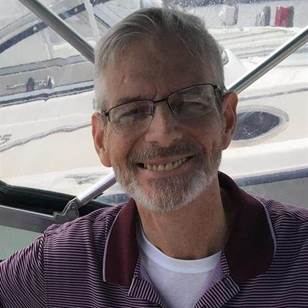
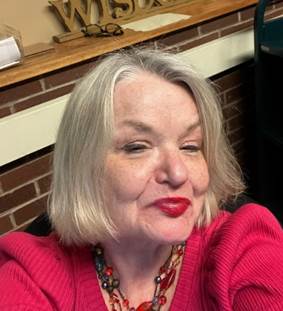
Stephen Seuling (1958-2021) Robbin Byrne
His brother Don and his wife, Linda James live in Ronkokoma, New York; they were blessed with daughter Allison and son Donald. Youngest brother James married Cathy Quatracci. Their son Tristan (1996) was one of the recipients of a scholarship awarded by recycling company Gershow to graduating seniors at various high schools around Long Island.
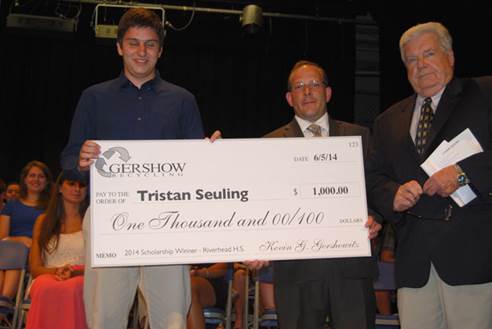
Tristan Seuling of Riverhead High School receives a scholarship.
Second daughter Emma married Alfred Coppola and lived her entire life in New Jersey where she raised son Alfred and daughter Laurel.
Brother John passed away around 1966, leaving no children.
Finally, William Seuling, born in 1910, and his wife Louise raised son Alan and daughter Janet. After a career in banking, William retired to Florida; Alan and his spouse Lorraine Smith have daughters Bonnie and Janet and son Andrew, born in 1976.
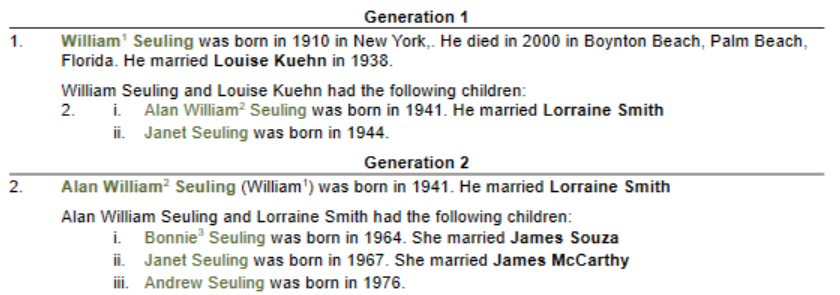
Descendants of William Seuling (1910-2000).
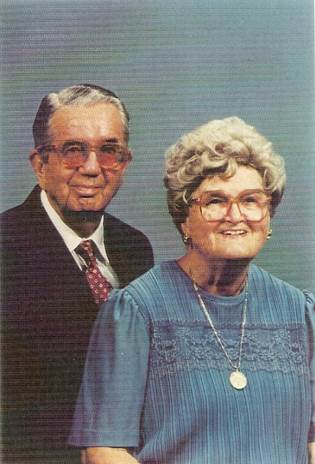
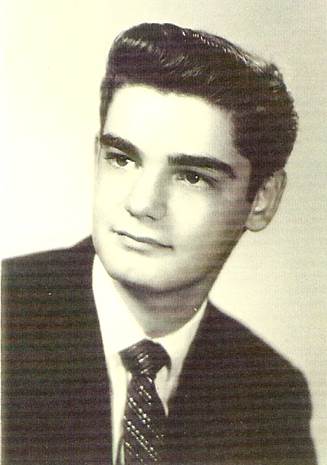
William Seuling (1910-2000) and his spouse Luise Kuehn as well as their son Alan (1941).
Henry Wilhelm Seuling (1881 -1962)
We know virtually nothing about Henry Wilhelm and his spouse Emily Amelia Simon (1883-1907). Through “soft”, i.e. somewhat suspect, internet information we learned he is a son of William Seuling and Margaret Becker. They had two sons: Henry Wilhelm and Joseph Henry plus daughter Amelia Emily. Apart from the names and the dates we are stuck.

Offspring of Henry Wilhelm Seuling.
N.N. Seuling and his son Henry J. (1904-1999)
Charles Henry Seuling (1904-1959) had “a distant cousin Henry J. Seuling who lived in Ridge, N.Y. and who in turn had a son Henry J. Jr. of Hicksville and Greenville, N.Y. and a grandson Robert W. living in Port Jefferson Station, N.Y.” It took a while for the three unity to shape. Henry J. Seuling was born in 1904 in New York; his son Henry J. Jr. in 1935 in Walden, New York and grandson Robert W. in 1959 in Port Jefferson Station, New York. However, we were not able to close the gap with Charles Henry and his grandparents William Seuling and Margaretha Becker. For a long time we pursued a connection with the Seuling tribe in Alten-Buseck; Seuling is a common name in this small community whereas Becker is by far the most common one. Although we haven’t given up hope, as yet we didn’t succeed.
We therefore had to fill the gap with an unidentified “N.N. Seuling” that, we assumed, was the son of William Seuling and Margaretha Becker. The distant relationship then would shape up as sketched: they indeed were cousins, i.e., not very distant. However, it cannot be excluded that their connection would be made one generation before in which case we would have to add another N.N. Seuling in both lines.

Possible relationship between Henry J. and Charles Henry Seuling.
Henry J. married Christine Heinsohn; no further details known. They had three, possibly four children: Jean, Henry J. Jr, Ann and perhaps Claire.
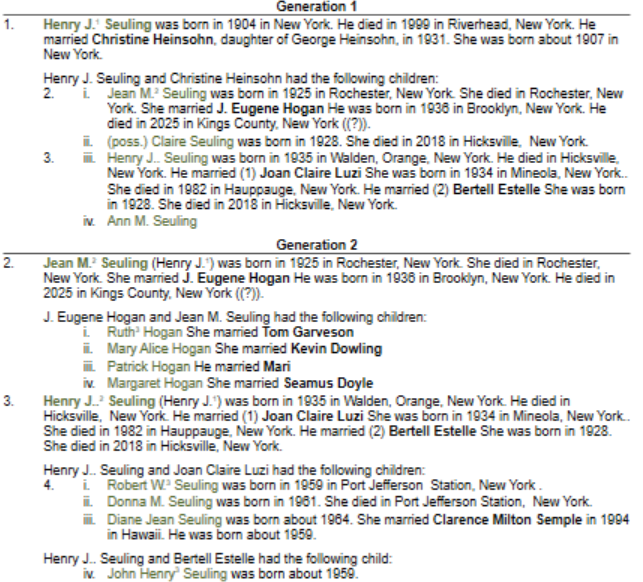
Descendants of Henry J. Seuling (1904-1999).
Daughter Jean M. Seuling (1925- 2010 Rochester) married J. Eugene Hogan, Gene was a graduate of Kings Park High School and held degrees from Adelphi University and University of Long Island. He spent time in the Suffolk County Police Department and served honorably as a Captain in the U.S. Army. He enjoyed a career in nursing and hospital administration at Kings Park Psychiatric Center. Eugene loved to fish, hunt and camp. He was a self-taught carpenter who took pride in many DIY projects and home renovations. Eugene and Jean spent many years traveling and having adventures around the world eventually moving in their retirement to Stuart, Florida.
Jean and Gene most likely were the parents of Anne, Ruth (married with Tom Garveson), Mary Alice (married with Kevin Dowling), Patrick (married with Mari) and Margaret (married with Seamus Doyle). However, the internet provides confusing information; further confirmation is needed.
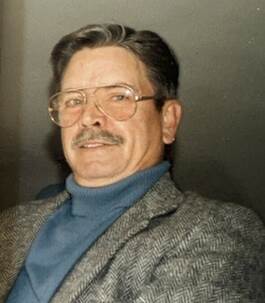
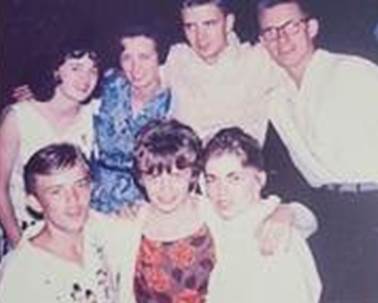
Eugene Hogan Possibly: a family portrait
Son Henry J. Jr. – Hank – added a new dimension to the family tale. In 1961 he showed up as a member of the Hicks Drill Team, judging from the number of trophies a fierceful competitor in this special sports event. Volunteer fire departments across the state would gather to compete against their rivals in speed, accuracy, and skill. A high-speed streamlined racing car – which is not particularly suited for regular firefighting – roars down the asphalt road with a group of men perched on the tailboard, ready to leap. When the precise moment is reached, brakes squeal and the firefighters jump for the hydrant carrying hose lines or dash up a ladder to make the best time possible.
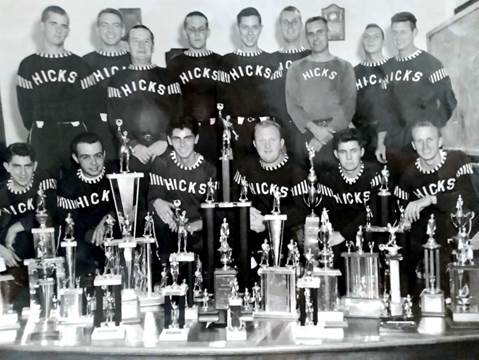
The 1961 Hicks Drill Team with – farthest back, fourth from the right – Hank Seuling.
For over 81 years, the Hicksville Fire Department hosted the Invitational Parade and Drill on Labor Day weekend, which has become the most watched event across New York State. For some unknown reason, Long Island is a hotbed of such competitions and home to about 80 of New York State’s hundred or so drill teams. During the Hicksville Labor Day Parade thousands of spectators gather to watch the parade on Sunday and come back the following morning to watch the drill competition. The 1961 event, however, witnessed a dramatic drop in attendance when a heatwave enabled temperatures to reach 98°.

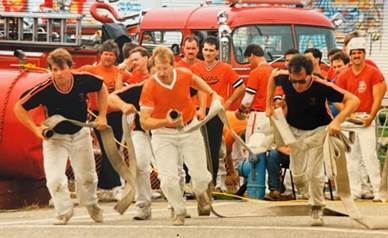
Labor Day Parade… …and Drill.
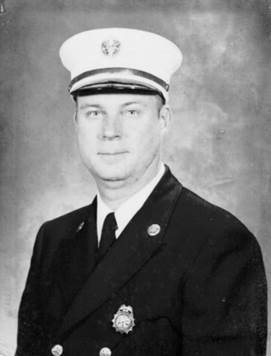
Henry “Hank” J. Seuling, Jr.
Hank married twice. With Joan Clair Luzi he had three children, the oldest of which was Robert W. who in turn had daughters Chelsea and Courtney. With Bertell he added son John Henry.
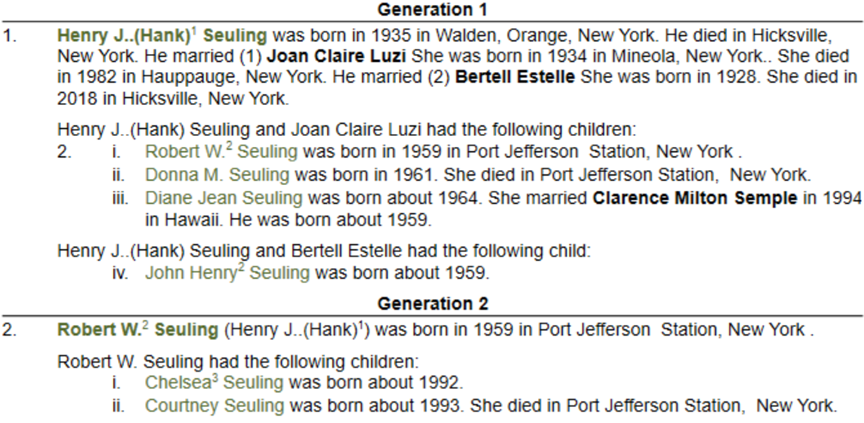
Descendants of Hank Seuling.
10d.3 The Ohio branch headed by John Seuling (1852-1913)
Dates and sometimes places: that is pretty much what we know on this Seuling branch. John Seuling (1852-1913) and Caroline Klaus (861-1888) (other sources say the bride was Mary Klause) had at least two daughters Elizabeth (1881) and Marie (1883).
Elizabeth Seuling (Lizzie; 11 August 1881 Oak Harbor, Ottawa County, Ohio – 1941 Painesville, Ohio) married in 1900 in Cuyahoga, Ohio with William Peter Eland (1880 Cleveland – 1937 Painesville, Ohio). He was the son of Johann Eland (1829 Aschaffenburg, Bayern – 1904 Cleveland) and Mary Ann Arnold (1836-1922), who had married in 1872. A vague wedding photogaph is as close as we get as yet. Lizzy and William on East Main Street in Madison Village where they had twelve children; our data base misses one.
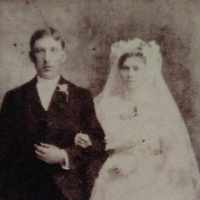
Lizzy Seuling (1881-1941) with husband William Eland; 1900.

Vintage postcard of Main Street in Madison, Ohio; ca 1910.

Descendants of John Seuling (1852-1913).
Oldest son Aloysius and his spouse Kathryn had son Aloysius, nicknamed Ted, who died in 2013 in Geneva, Ohio. Ted was a lifelong Ohio resident who never lived far from his childhood home. After graduating from Madison Memorial High School, he served four years in the U.S. Navy from 1952 until 1956. Ted served on the USS Menhaden, a Balao-Class submarine, in the East and South China Seas and West Pacific. Upon returning to Madison in 1956, Ted joined Local 673 of the International Brotherhood of Electrical Workers and began his lifelong career as a construction electrician. Ted eventually served as the Assistant Business Manager of the Local and later was elected to his first of two consecutive terms as Business Manager of Local 673. In 2012, Ted was recognized for his 55 years of membership in Local 673. Ted held firm to his strong union beliefs his entire life.
Upon his retirement, Ted traveled the country extensively with his wife Jill. In the past 15 years, they enjoyed spending time in their summer place at Holiday Camp Lands in Andover, Ohio.
Son Nr. 10, William George Eland (1920 Madison, Ohio – 2015 Titusville, Florida), served in the US Marine Corps. In 1941 he married Edwardine M Cone (1920-2002); they had 9 children: Sandra (1941), Vicki (1943), Judith (1945), Michael (1950), Douglas (1951-2003), David (1952-1969), Daniel (1954), Timothy (1960-2003) and Teresa (1963).
William and many of his siblings had a catholic burial, suggesting that this may be a branch of the Bavarian Seuling tribe.
10d.4 The Cleveland branch headed by John Seuling (1853-1913)
Although not 100 percent certain, it appears that John Seuling (1853 Germany – 1913 Cleveland) married Bridgette Mcmannon and had daughters Mary Ann (1878 Cleveland), Elizabeth Anna (1881 Harris, Ohio – 1941) and Marie C (1883 Harris, Ohio – 1945).

Tentative offspring of John Seuling.
Mary Ann and Marie both married. We have not been able to track their offspring with the one notable exception: Mary Ann’s youngest son James J. Kilroy worked as a salesman for Kraft Foods and lived to be 93years old.
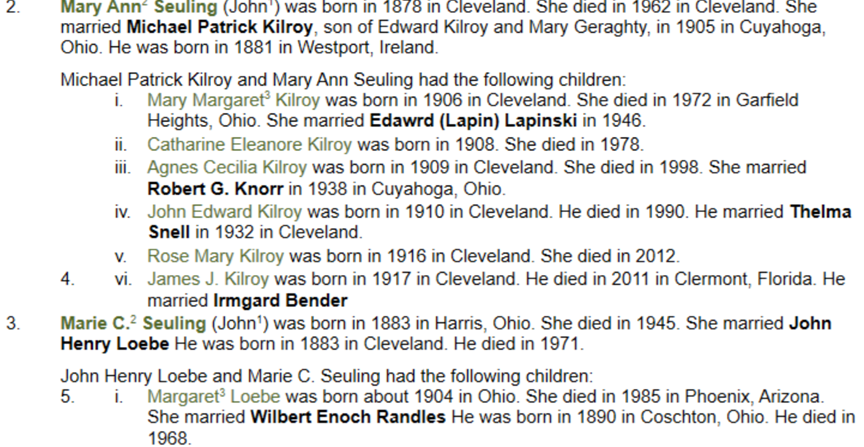
Offspring of Mary Ann and Marie Seuling.
10d.5 The Buffalo/Olean branch headed by Peter Seuling
Way back, when we started our noble effort to connect all Seulings worldwide, we first encountered John J. Seuling and his spouse Anna Cushing/Suching. Living in and possibly around Olean, New York, they were the proud parents of five children. No further details were known regarding John J. Jr. and his sister Mary M. except their deaths before 1999.
From our early N.Y. correspondent Barbara Seuling, we learned John had two daughters Catherine and Dorothy Seuling living in Washington, D.C. She suggested they might share our interest in genealogy and perhaps could help us in completing the overview of the American branches and the roots that connect them to Germany. A telephone interview during a Washington visit suggested their father John was one of six children, probably three boys and three girls. He grew up in or around Buffalo, New York. As his father died young, much of the oral family history is lost; the last name of the grandmother of Catherine and Dorothy possibly was Volk.
It took us thirty years and some serious internet digging to confirm oral history often is based on solid facts. According to our current, limited insight the mini-branch is headed by Peter Seuling who was born in Germany in 1849 but surfaced at the other side of the ocean in Buffalo, New York. It may be that Peter hotfooted to the New World because the situation at home was somewhat complicated. In January 1872 a Peter Seuling; farmer and conscripted soldier from Steinsdorf, 22 years old, is charged with desertion. Steinsdorf is just east of Zettmannsdorf which we assume is the home site of the Bavarian Seuling tribe.


A Peter Seuling is charged with desertion; Bamberg, January 22, 1972.
We don’t know with 100 percent certainty that he is “our” Peter, but it is noteworthy that the latter most probably arrived at Ellis Island later that year. He married Anna Maria Volk, the daughter of Georg Volk and Anna Maria Bach who probably lived in Rieschweiler in the Rheinland-Pfalz region in Germany. She probably arrived as the ripe age of 2 in 1848 at Ellis Island aboard the Talisman.
Over the next decades we can now retrace their steps. In 1881 a Peter Seuling lived at 56 Weaver in Buffalo. According to the Buffalo City Directory, in 1885 he ran a saloon at 677 Sycamore in Buffalo. In 1995 he was a brewer living on 15 Dupont, together with Otto Seuling who was a printer. Shortly thereafter they must have moved to Olean, New York for when Peter died in 1897 he was buried in Saint Bonaventure Cemetery in the neighboring village Allegany. Once again the catholic cemetery suggests a connection with the Bavarian Seuling tribe.

Current Google street view of 56 Weaver Street: is it still the same house?
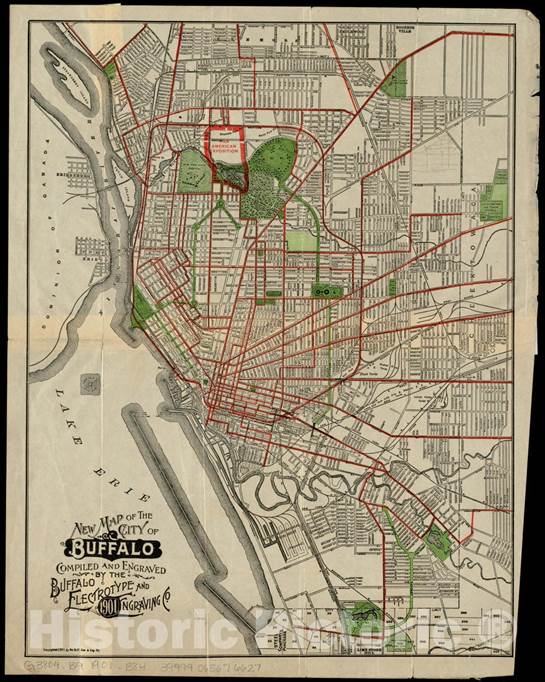
Vintage map of Buffalo; ca 1901.
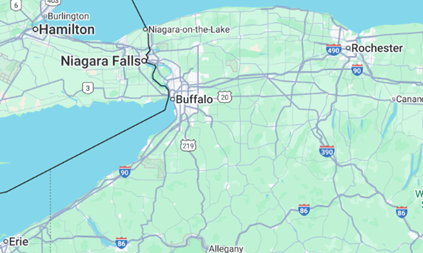
Allegany, south of Buffalo, is just West of the still smaller Olean, New York.
We don’t know what instigated the move from Buffalo. Olean had a rich history shaped by its location at the headwaters of the Allegheny River and its early role as a gateway to the West. Initially settled around 1805, it became a key embarkation point for settlers heading down the Ohio River. Lumbering was an early industry, and Olean also became a site for oil exploration due to its proximity to the Pennsylvania oil fields. As the oil-based economy waned, Olean transitioned to engineering industries, including the manufacture of turbines, compressors, and electric components. During the Prohibition era, it gained notoriety as a stopover for bootleggers and gangsters traveling between Chicago and New York City, earning it the nickname “Little Chicago”.
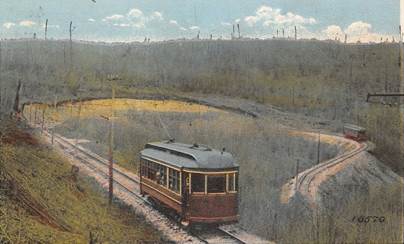
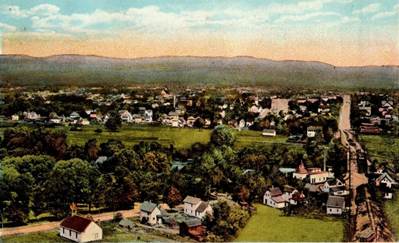
Left: horseshoe curve on trolley line between Olean, N.Y. , and Bradford, Pa.; ca 1910. Right: bird’s eye view of Olean; ca 1922.
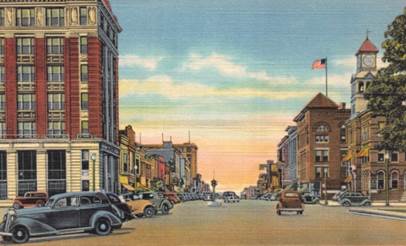
Union Street in the center of “Little Chicago”.
The Olean Directory 1902 shows the widow Anna M. Seuling and her eight children lived at 405 W. Green. The directory also provides us with an indication of their occupations. Oldest son Otto was a brewer; possibly his youngest brothers George, John J. and Jacob J. worked with him. Second son Peter was a painter, Joseph a bartender. Mame – formally Mary M. – was a book-keeper.

Olean directory 1902.
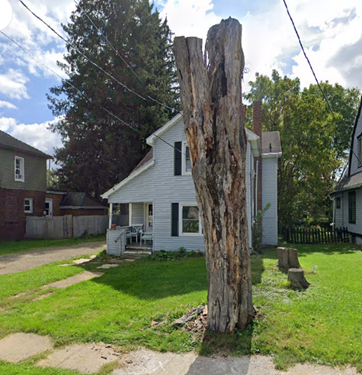
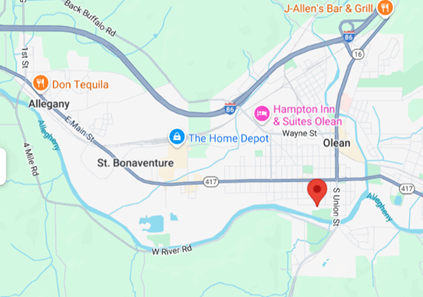
Current Google street view of 405 W. Green Street in Olean, New York.
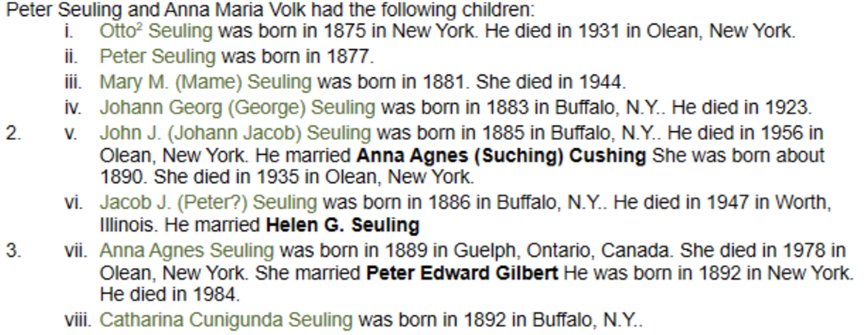
Offspring of Peter Seuling (1849-1897).
There’s much we don’t know about the offspring of Peter and Anna. Otto, Peter, George, Jacob J. and Catharina escape us. Mameapparently made a career of her book-keeping skills; in an overview of the officials of Olean for 1922/3 Mary M. Seuling is mentioned as the clerk of the Park Commission.
Our original lead, John J. Seuling died in 1956 in Olean. With Anna Suching he had five children, three of which we haven’t been able to trace as yet.

Offspring of John Jacob Seuling (1885-1956).
His oldest son and namesake John J. in turn married Clara Pellegrino, of good Italian descent. He died in 1965 in Buffalo where he lived on 78 Fargo Street. He was a former showman and manager of the Mure’s hat department.
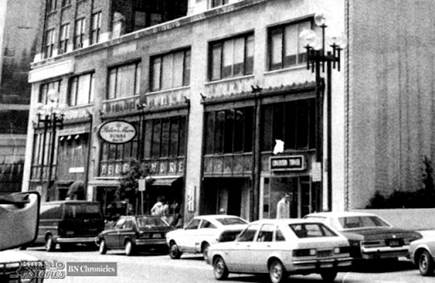
Peller & Mure was a Men’s habedashery, which opened in 1948. It became one of downtown’s great men’s stores with two locations. One on Court Street and the other on Delaware Avenue.
Son Edward Seuling – according to his November 1999 obituary – was a veteran of World War II, even a Pearl Harbor survivor, who retired from the U.S. Navy as a chief boatsman after twenty years of service. After his retirement he returned to Olean.

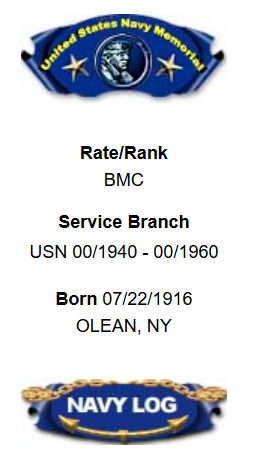
Edward William Seuling (1916-1999).
Our first contact, daughter Dorothy (1921 Olean – 2004 Washington, D.C.), came to Washington in the 1940’s and was a secretary at the law firm of Covington and Burling. Her travels took her to Combermere, Ontario Canada where she was a secretary to Baroness Catherine de Hueck Doherty when Catherine was writing the history of Madonna House Apostolate. Dorothy retired from the Department of Agriculture Foreign Agriculture Service (FAS) in 1986. She was a volunteer at the Washington Home, The Red Cross and also Meals on Wheels.
Anna Seuling (1889 Guelph, Ontario – 1978 Olean, New York) married Peter Edward Gilbert (1892 New York – 1984) and had daughter Mary Catherine Gilbert (1920 Olean, New York– 1983) and son James J. Gilbert (1928 Olean -2011) who married Mary Ellen Brooks.

Offspring of Anna Seuling (1889-1978).
Apart from the many gaps in the above family history, we also are confronted with a further “mystery”. In 1917 a Robert Seuling was buried in Olean, New York. He can’t be retraced in the 1902 directory so must have moved over at a later date. Lacking further information we tentatively assumed he was a brother of Peter Seuling.
10d.6 Loose ends
A number of Seulings who arrived in the U.S.A. around 1900 or where born around that time, still deserve further investigation:
- Anna (1895-1990)
- Christine (1907-1993 Suffolk, NY)
- Louise (1902-1981 Flushing, NY)
- Mary (1912-1974).
Arrivals at Ellis Island:
- Lorenz Seuling, age 27, from Zettmansdorf arrived in 1904.
- Carl, age 24, arrived in 1890.
- John, age 47, arrived in 1949 aboard the Veendam.
- Wilhelm C.F., age 30, arrived in 1896
- Margareth, age 16, from New York arrived in 1926 aboard the Berengaria.
- Maria, age 17, arrived in 1925 aboard the Westphalia.
- Justus, age 29, from Buseck arrived in 1861.
- Born ca 1832: could be son of Johan Philipp (John), born 1831 but he supposedly died after 1845 in AB
Questions, questions, questions: Luise Seuling, age 29 from Arnswalde arrived at Ellis Island in 1931 aboard the Deutschland. She is accompanied by her 3-year old daughter Edith, who was born in Brooklyn, however. Could she be the spouse of Johannes Seuling, age 20, from Zettmansdorf who immigrated in 1922?
Edith married Wilhelm Degenfelder in 1951 in Kings County, New York. Wilhelm was CPL in the US Army during the Korean War. Edith died in Ronkonkoma, New York.
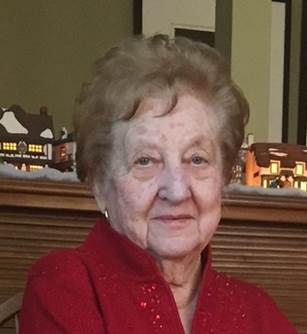
Edirh Seuling (1928-2017)
Rudolf K. Seuling married Else E. Kauz (1924 – 2005 Glendale, Arizona) who was born in Frankfurt, Germany on June 7, 1924 to Emil and Theresa (Wolf) Kauz. She moved to Arizona 19 years ago from Illinois. They had 2 daughters, Helga Trish of Glendale and Susan Borkland of Phoenix, Arizona; one son, Wolf Seuling of Desert Hills, Arizona; 3 grandchildren.
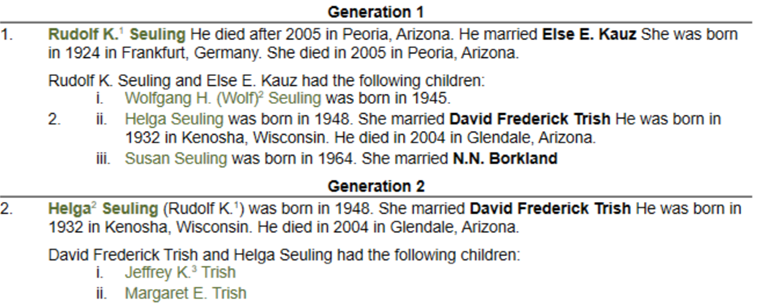
Offspring of Rudolf K. Seuling (abt 1920 – aft 2005).
Helga graduated from Downers Grove South in 1969. She married David Trish from Kenosha, Wisconsin and had daughter Margaret and son Jeffrey.
Son Wolfgang (Wolf) went to Downers Grove North High School. With the apparent nickname Muffler, he was actively involved in drag racing and apparently made a career of cars.

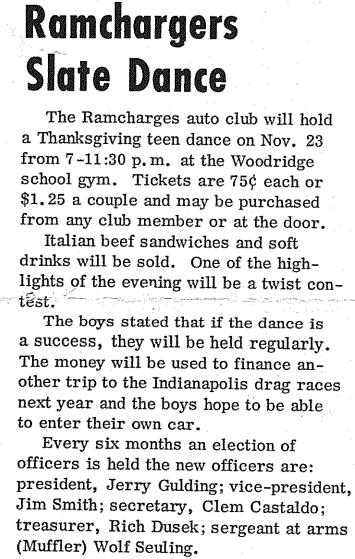
Wolf Seuling – Muffler – is sergeant at arms at the Ramchargers auto club.

Wolf and his unique vehicle.
Their kid sister Susan (Sue), some twenty years younger, lived at 7756 Woodridge Drive from 1964 to 1973, and at 2703 Woodridge Drive until 1984. She went to Downers Grove South from 1978 to 1982 and married N.N. Borkland.
